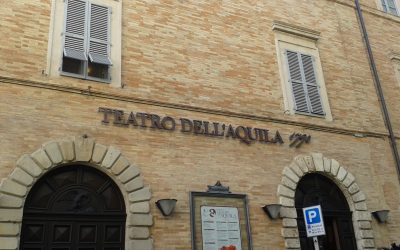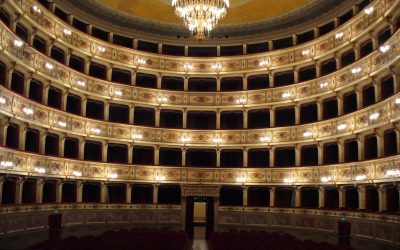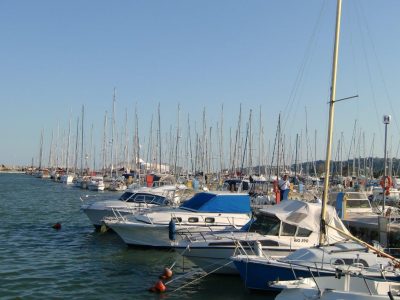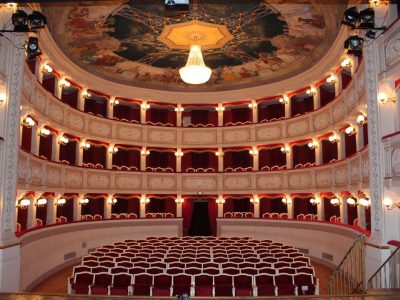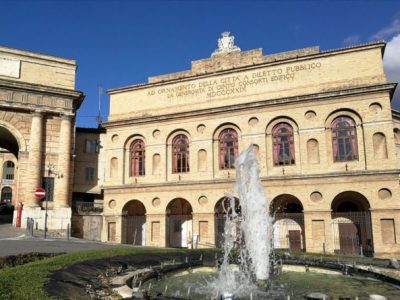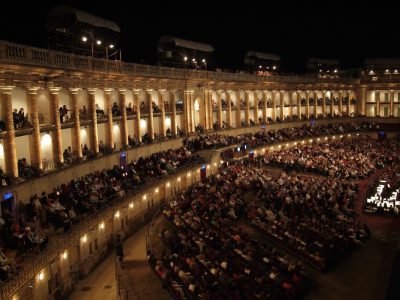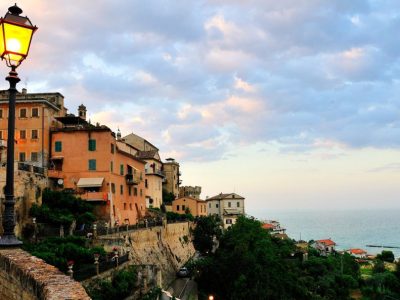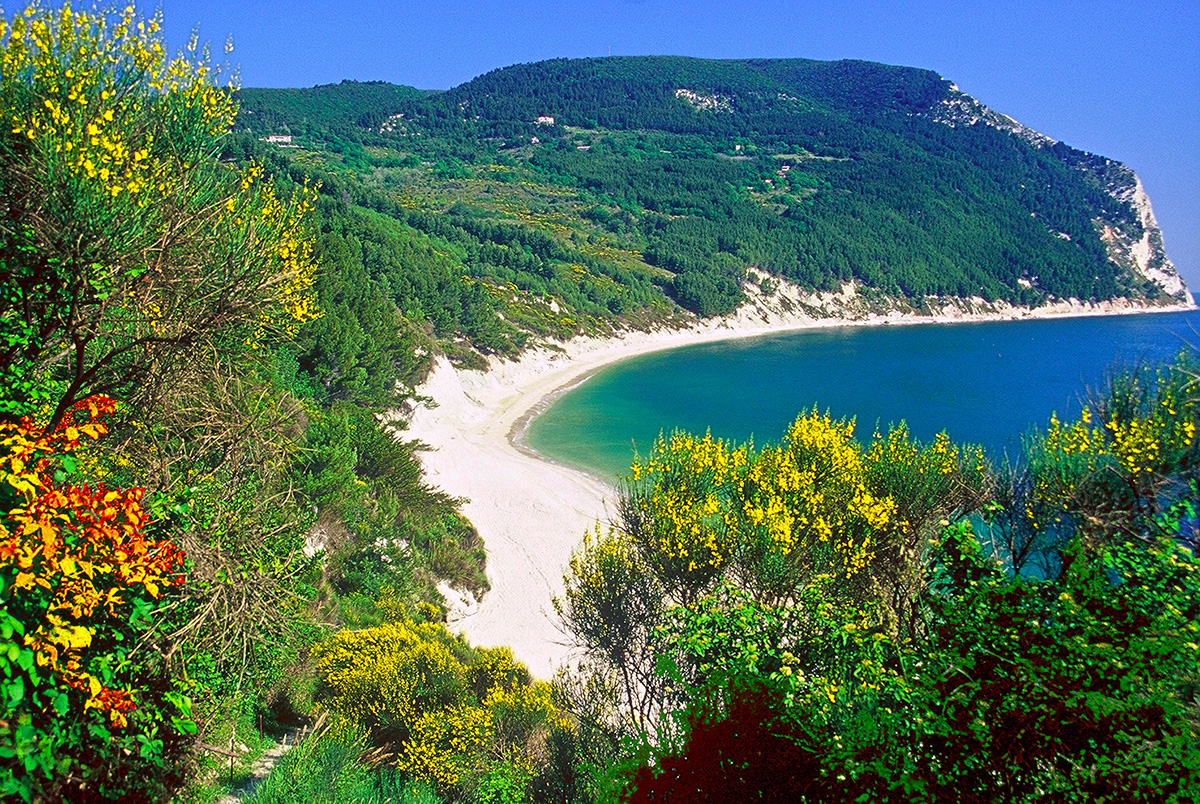Teatro dell'Aquila Fermo
Going up towards the Cathedral, along Via Mazzini, one enters the splendid “Aquila” Municipal Theater. It was built on a project by the architect Cosimo Morelli of Imola (1729-1812) starting from 1780 to replace the wooden one, lost due to a fire, which was placed in the current Sala dei Ritratti in the Palazzo dei Priori. Opened on 26 September 1790, the Theater has been for over 200 years one of the main poles of the cultural activity of the Marches. It counts one hundred and twenty-four boxes on five orders to frame the audience for a total capacity of about 1000 seats. Valuable is the painting of the ceiling, painting in tempera by Luigi Cochetti (Rome 1802-1884), a pupil of Minardi, depicting the Numi dell’Olimpo, with Jupiter, Juno, the three Graces and the six Dancing Night Hours, intent on listening the song of Apollo.
In the middle there is a 56-light chandelier made of gilded iron and wooden leaves, originally powered by carbide ordered in Paris in 1830. The curtain is also noteworthy, also by the painter Luigi Cochetti, depicting Armonia who gives the zither to the genius Fermano. On the occasion of the solemn reopening in 1830 the scenographer Scaligero Alessandro Sanquirico (Milan 1777-1849), the eldest of the time, painted for the theater some suggestive backdrops, four of which are still kept in the warehouses.
Porto San Giorgio
Porto San Giorgio is a small town located in the Marche coastline. It borders on three sides with the municipality of Fermo and on the east with the Adriatic Sea. It is an important seaside resort with a sandy beach, with numerous accommodation facilities and a well-equipped marina. It is characterized by an upstream part with the district Castello and la Rocca and, beyond the highway, from the marina.
The Rocca Tiepolo stands mighty and solitary with the Mastio, the walls of crenellated guelphs, protected by tall maritime pines. Worth seeing are: the historical theater “Vittorio Emanuele” of the early twentieth century, the nineteenth-century church of San Giorgio, the Villa Bonaparte, built at the request of Napoleon’s brother, Girolamo Bonaparte, who stayed in Porto San Giorgio between 1829 and 1832, and the Baroque church of Suffrage.
Countless are the elegant buildings that are intertwined with the most popular alleys; green corners and squares alternate with new buildings. The promenade is enriched with centenary palms, enhanced with flooring and lighting that are the charming setting for the Art Nouveau buildings. The typical dishes are the garagoli (sea snails in broth with red sauce and spices) and the brodetto. Among the traditional agri-food products, vin cotto is worth mentioning.
Macerata Sferisterio
The Sferisterio di Macerata is a unique theatrical structure of its kind. Wished by the initiative of Cento Consorti, it was designed in 1823 by the neoclassical architect Ireneo Aleandri, for the game of the ball to the bracelet. Only in 1921 was it transformed into a lyric theater: the only one in the open air.
The monumental but intimate structure, with its 2500 seats, 104 stages and the longest stage in Europe, guarantees perfect visibility and excellent acoustics.
After the first two lyric seasons of 1921 and 1922, from 1967, the year of the reopening with Otello by Mario Del Monaco, the Sferisterio hosted the most legendary artists: Luciano Pavarotti,
Katia Ricciarelli, Renato Bruson, Montserrat Caballé, Placido Domingo, Rudolf Nureyev, Carla Fracci, Roberto Bolle. History has gone down in history, such as the famous Traviata degli Specchi by master Josef Svoboda, in 1992, and the unforgettable Bohème by Ken Russel, in 1984 and by Leo Muscato in 2012, the most recent Abbiati award of the opera from Macerata.
Grottammare
Grottammare overlooks the Adriatic coast among the green of its pinewoods, orange groves and palm trees, with its golden beaches and the clear light of the sea. The clean waters, the coast of fine sand, the enchantment of the evocative glimpses of the ancient village and the lush vegetation, make up a fresco of colors and forgotten perfumes that make our town unique.
The concomitant presence of these elements, together with the functionality and quality of the services have assured Grottammare the important recognition of F.E.E.E. (Foundation for Environmental Education in Europe) for the award of the Blue Flag, which the European Union awards each year to the administrations that have distinguished themselves
for the perfect quality of the water, the care of the urban furnishing, the maximum functionality of the purification systems and the excellent offer of tourist services. An important recognition to which over the years have been joined by other prestigious titles such as the 3 sails of the Blue Guide of the Touring Club and the inclusion of the old incasato, clinging on the hill, among “The most beautiful villages in Italy”. Grottammare stands out among the other towns of the Adriatic coast for its privileged position, surrounded by lush vegetation, sheltered to the west by gentle slopes and lapped by the sea to the east. The particular location ensures that it can enjoy a mild climate throughout the year, such as to allow the happy development of the numerous Phoenix canariensis palms, native to the Canary Islands, next to the orange plants, which embellish the landscape of Grottammare, constituting one of the most relevant peculiarities of the area. It is no coincidence that two orange trees stand out in the crest of the city: they flank a crenellated circular tower that represents the fortified tour of the walls, typical of medieval centers, and recalls the ancient lighthouse of the city port.
Riviera del Conero
The Conero Riviera offers the opportunity to experience a unique holiday between the sea and the hills, enriched by an incredible range of events, culture and gastronomy. The Conero houses facilities suitable for every type of holiday, starting from trendy hotels passing through B & B, Farmhouses and Country Houses immersed in the green or set within one of the many ancient villages built at the foot of a castle. The Riviera del Conero also offers campsites and villages equipped in varied nature, up to comfortable apartments and holiday homes for rent close to very long beaches.

